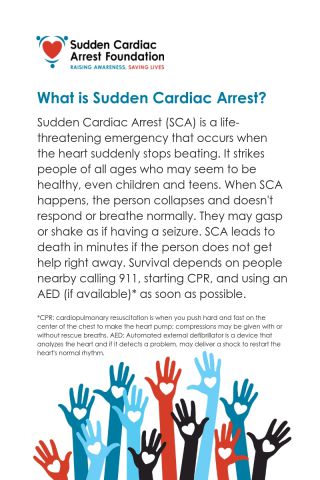
Once laypersons understand Sudden Cardiac Arrest, they are highly motivated to give CPR and apply an AED—critical actions that will save more lives.
Sudden cardiac arrest (SCA) is a public health crisis. More than 356,000 cardiac arrests occur outside hospitals annually in the U.S. and nearly 90 percent of them are fatal. Survival depends largely on immediate bystander intervention with CPR and the use of automated external defibrillators (AEDs). However, less than 4 in 10 victims receive bystander CPR, and less than 2 in 10 victims are treated with AEDs by bystanders before EMS arrives. Yet, bystander CPR can triple survival, and bystander AED use is associated with better survival and functional outcomes.
Recognizing the opportunity to increase survival rates, the Sudden Cardiac Arrest Foundation set out to learn more about public awareness and bystander action, working in partnership with Jennifer Chap and her colleagues at StrataVerve, a global consumer research firm. Our 2015 baseline study about awareness and understanding of SCA, CPR, and AEDs indicated that SCA simply is not on the public’s radar. Moreover, we learned there is considerable confusion about SCA, which is creating unintentional apathy with deadly consequences.
In our 2017 follow-up study, presented at the 2018 American Heart Association Resuscitation Science Symposium, we hypothesized: Low public awareness and understanding of SCA contributes to low survival rates; A layperson-friendly definition of SCA could improve the perceived importance of CPR/AED skills and the likelihood to give CPR/apply an AED in an emergency; and Identifying messages that motivate action could help reveal an effective communications strategy.
The quantitative component of the study was an online survey conducted among a representative national sample of adults provided by Survey Sampling International (n=2,232). Respondents answered framing questions and then were split into two matched panels.
Panel A (n=1,128) was exposed to a layperson-friendly definition of SCA that was drafted, peer-reviewed and simplified to an 8th grade reading level.[1] Questions pre- and post- exposure to the definition measured shifts in “importance to learn” skills and “likelihood” to give CPR/apply an AED. The resulting “lift” factor was applied to 2017 CARES (Cardiac Arrest Registry to Enhance Survival) data to estimate the potential life-saving impact of understanding.
Panel B (n=1,104) was exposed to 11 discrete messages, developed in partnership with the National Cardiac Arrest Collaborative. Messages were evaluated on their relative strength in grabbing attention and motivating action.
The qualitative component of the study consisted of 20-minute in-person interviews (n=20 from 10 states) that teased out softer insights.
We learned from Panel A that understanding drives action. Once respondents were exposed to the tested definition of SCA, those who said they were “very likely to act” increased dramatically. Twenty-six percent said they were more likely to give CPR (38% vs. 48%). In addition, 38 percent said they were more likely to apply an AED (26% vs. 36%).
And, when we applied the “lift” factor to 2017 CARES data, we learned that bystander CPR could save 13.7% more lives. This equates to thousands more lives that could be saved each year.
In addition, since most SCAs (68.5%) occur in the home, we concluded that the combination of greater understanding of SCA and the need for immediate bystander action, plus more widespread deployment of AEDs in homes, could result in saving many more lives.
We learned from Panel B that the following two messages, among the 11 messages we tested, are most likely to motivate bystander action. The clear winners were: “You can double or triple a person’s chance of survival from sudden cardiac arrest by immediately giving CPR,” and “You may save the life of someone you love as most sudden cardiac arrests happen at home.”
We concluded:
- A layperson-friendly definition of sudden cardiac arrest increases public understanding and bystander action.
- Using “sudden” when referring to cardiac arrest is important, since the word conveys a sense of urgency and the potential of SCA to strike seemingly healthy, younger populations.
- Two key messages (noted above) resonate on both rational and emotional levels.
- As the public’s understanding grows, support for more accessible AEDs and demand for lower-cost home AED models could increase.
We urge all organizations concerned with survival from SCA to adopt the layperson-friendly definition and the key messages we have tested. If we work in collaboration and speak with one voice, we may be able to dramatically improve survival from sudden cardiac arrest.
By Mary M. Newman, MS, President, Sudden Cardiac Arrest Foundation
See Revive blog here.
[1]Refined definition: “Sudden Cardiac Arrest (SCA) is a life-threatening emergency that occurs when the heart suddenly stops beating. It strikes people of all ages who may seem to be healthy, even children and teens. When SCA happens, the person collapses and doesn’t respond or breathe normally. They may gasp or shake as if having a seizure. SCA leads to death in minutes if the person does not get help right away. Survival depends on people nearby calling 911, starting CPR¹, and using an AED² (if available) as soon as possible.”
1CPR: Cardiopulmonary resuscitation is when you push hard and fast on the center of chest to make the heart pump; compressions may be given with or without rescue breaths.
²AED: Automated external defibrillator is a device that analyzes the heart and if it detects a problem may deliver a shock to restart the heart’s normal rhythm.- Log in to post comments
